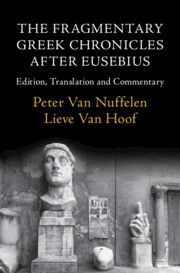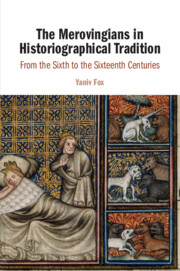Refine search
Actions for selected content:
29 results

The Fragmentary Greek Chronicles after Eusebius
- Edition, Translation and Commentary
-
- Published online:
- 11 September 2025
- Print publication:
- 24 July 2025
107 - Clement of Antioch, Chronicle
-
- Book:
- The Fragmentary Greek Chronicles after Eusebius
- Published online:
- 11 September 2025
- Print publication:
- 24 July 2025, pp 333-353
-
- Chapter
- Export citation
115 - Itios, Chronicle?
- from Dubia
-
- Book:
- The Fragmentary Greek Chronicles after Eusebius
- Published online:
- 11 September 2025
- Print publication:
- 24 July 2025, pp 513-517
-
- Chapter
- Export citation
119 - Pseudo-Jacob of Nisibis, Chronicon
- from Dubia
-
- Book:
- The Fragmentary Greek Chronicles after Eusebius
- Published online:
- 11 September 2025
- Print publication:
- 24 July 2025, pp 535-539
-
- Chapter
- Export citation
Introduction
-
- Book:
- The Fragmentary Greek Chronicles after Eusebius
- Published online:
- 11 September 2025
- Print publication:
- 24 July 2025, pp 1-58
-
- Chapter
- Export citation
117 - John Chrysostom, Letter to Acacius of Melitene
- from Dubia
-
- Book:
- The Fragmentary Greek Chronicles after Eusebius
- Published online:
- 11 September 2025
- Print publication:
- 24 July 2025, pp 525-531
-
- Chapter
- Export citation
3.1 - Forms before Genres
- from History 3 - Forms
-
-
- Book:
- The New Cambridge History of Russian Literature
- Published online:
- 31 December 2024
- Print publication:
- 12 December 2024, pp 465-481
-
- Chapter
- Export citation
II.41 - Military Historiography
- from Fifteenth Century
-
- Book:
- The Cambridge Anthology of British Medieval Latin
- Published online:
- 11 January 2024
- Print publication:
- 01 February 2024, pp 357-377
-
- Chapter
- Export citation
II.34 - Historians of the Fourteenth Century
- from Fourteenth Century
-
- Book:
- The Cambridge Anthology of British Medieval Latin
- Published online:
- 11 January 2024
- Print publication:
- 01 February 2024, pp 309-317
-
- Chapter
- Export citation
I.36 - Æthelweard, Chronicle
- from Tenth Century
-
- Book:
- The Cambridge Anthology of British Medieval Latin
- Published online:
- 11 January 2024
- Print publication:
- 01 February 2024, pp 386-395
-
- Chapter
- Export citation
I.41 - Three Accounts of King Alfred and the Cakes
- from Eleventh Century
-
- Book:
- The Cambridge Anthology of British Medieval Latin
- Published online:
- 11 January 2024
- Print publication:
- 01 February 2024, pp 444-449
-
- Chapter
- Export citation
I.28 - The Coming of the Vikings and the Destruction of Lindisfarnein 793
- from Eighth Century
-
- Book:
- The Cambridge Anthology of British Medieval Latin
- Published online:
- 11 January 2024
- Print publication:
- 01 February 2024, pp 313-322
-
- Chapter
- Export citation

The Merovingians in Historiographical Tradition
- From the Sixth to the Sixteenth Centuries
-
- Published online:
- 02 November 2023
- Print publication:
- 16 November 2023
Chapter 4 - Lydgate and the Surplus of History
-
- Book:
- Matter and Making in Early English Poetry
- Published online:
- 15 June 2023
- Print publication:
- 29 June 2023, pp 111-138
-
- Chapter
- Export citation
Chapter 1 - Words and Deeds in Chaucer
-
- Book:
- Matter and Making in Early English Poetry
- Published online:
- 15 June 2023
- Print publication:
- 29 June 2023, pp 15-51
-
- Chapter
- Export citation
5 - Eventful Analysis
- from Part II - How to Use History to Describe Patterns
-
- Book:
- The Grammar of Time
- Published online:
- 11 May 2023
- Print publication:
- 25 May 2023, pp 73-93
-
- Chapter
- Export citation
1 - The Romans, Christ and Paul
-
- Book:
- Resetting the Origins of Christianity
- Published online:
- 30 December 2022
- Print publication:
- 12 January 2023, pp 10-53
-
- Chapter
- Export citation
Chapter 17 - Bodies
- from Part IV - Connectors
-
-
- Book:
- Latin American Literature in Transition 1870–1930
- Published online:
- 14 January 2023
- Print publication:
- 08 December 2022, pp 252-266
-
- Chapter
- Export citation
16 - Chronicle, Genealogy and Narrative: Understanding Synthetic Biology in the Image of Historiography
- from V - Research Narratives
-
-
- Book:
- Narrative Science
- Published online:
- 16 September 2022
- Print publication:
- 06 October 2022, pp 328-348
-
- Chapter
-
- You have access
- Open access
- HTML
- Export citation
Chapter 6 - Life, Love and the Past
-
- Book:
- Writer and Occasion in Twelfth-Century Byzantium
- Published online:
- 03 December 2020
- Print publication:
- 17 December 2020, pp 142-169
-
- Chapter
- Export citation
